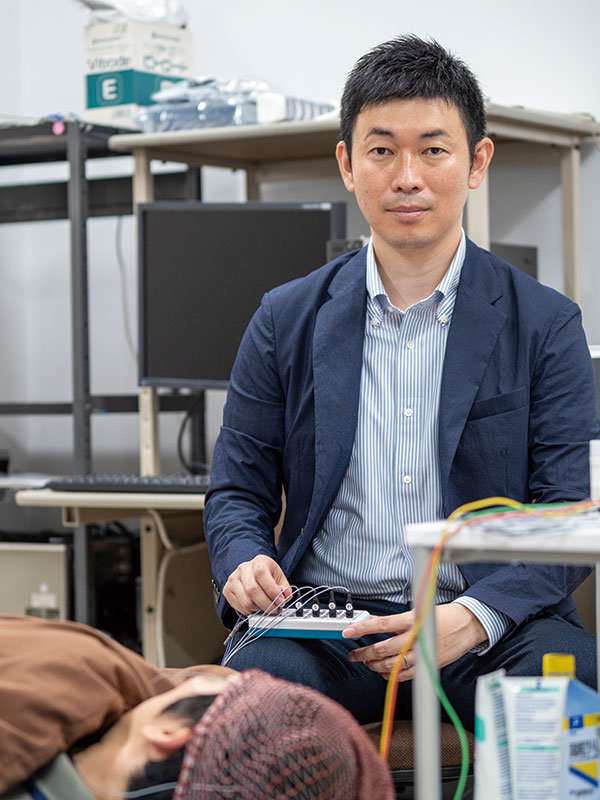Elucidating the mechanisms of sleep control Prompted by the direct experience of a young soccer athlete

UTokyo 30s
Up-and-coming young researchers
Of the approximately 5,800 faculty members active at the University of Tokyo, we have selected nine energetic young researchers in their 30s. In terms of their job titles, there is one professor, two associate professors, one project associate professor, one lecturer, one project lecturer and three research associates. What kind of research are they engaged in day to day? And what is their temperament like? Let’s find out.
| Sleep Science |
Elucidating the mechanisms of sleep control
Prompted by the direct experience of a young soccer athlete
 Akifumi Kishi Akifumi KishiResearch Associate, Graduate School of Education |

At the Graduate School of Education, which is considered a humanities school at the University of Tokyo, Research Associate Akifumi Kishi is on the staff of a physical and health education course in which many of the other researchers come from science backgrounds. Mainly through physiological measurements (including electroencephalograms, heart rate monitoring and electromyograms) and the mathematical analysis of the resulting data, he is working to elucidate the phenomenon of sleep, arguably one of life’s great mysteries. But he says that his decision to pursue sleep science was not because he suffered from insomnia himself.
“I used to play soccer as one of my club activities in high school, but because I was studying to go to university, I needed to set aside enough time for study, even when I was tired from practice. In that context, I found that I could get better results on my exams by sleeping, even if it was just for two or three hours, than by staying up all night to study. That made me realize the importance of sleep.”
That high school student from Takasaki, Gunma Prefecture, who realized that getting a good night’s sleep after taking in new knowledge worked to shift it from short-term to long-term memory, ended up attending the University of Tokyo by impressively taking control of this relationship between study, exercise and sleep. There, he mastered the fundamentals of sleep science while throwing himself into the activities of the futsal team and playing an active role in the position of “fixo” (the “fixed defender” who takes a bird’s-eye perspective in an attempt to control the game). In one project, he investigated the cumulative effects of mildly reduced four-hour sleeps on workers.
“That was a harsh experiment in which twenty-four subjects placed themselves under supervision for a period of two weeks. Just carrying out the study was tough for me as well. Every time someone went to the bathroom, I needed to disconnect and then reattach the monitoring device, which made even napping difficult.”
Kishi demonstrated that when light sleep deprivation continues, work efficiency clearly deteriorates, even without any subjective symptoms. After attending graduate school and a research internship at the New York University Langone Sleep Disorders Center, he upended the conventional wisdom of alternating cycles of REM sleep and non-REM sleep every 90 minutes. He found that each 90-minute cycle contained finer-grained state transitions with an underlying mathematical regularity. This was an outcome that was also applicable to the treatment of illness.
“We found that REM sleep was disrupted in those with chronic fatigue syndrome and that slow-wave sleep was disrupted by fibromyalgia. The latter, for example, is improved by applying a weak electrical stimulus to the appropriate part of the brain. We are now working on trying to control brain state transitions to ensure high-quality sleep.”
Another project he is working on is to help people fall asleep. It’s often said that the moderate swaying when riding a bus causes drowsiness, but it is not that easy to recreate the same conditions in the home. However, Kishi says that simply applying a weak, imperceptible electrical stimulus behind the ears on the left and right sides of the head in alternation elicits a pseudo-swaying sensation in the brain. While elucidating the underlying principle of sleep is the first order of business, there is a chance that, in the future, a simple device like your smartphone might be able to help you fall asleep. As his research strives to alleviate problems with falling asleep and shows us how to better control sleep, Kishi may very well be the “fixo” of the sleep science world.
| Q & A | |
|---|---|
| Are you also on staff at the Gotenshita Memorial Arena on Hongo campus? | “I also work as a professional staff member at the sports counseling office. Exercise is good for sleep too, you know!” |
| What do you do on your days off? | “I bring my five-year-old and three-year-old children to campus and let them play around.” |
| Your nickname in the UTokyo Futsal Club was “Sanpachi-sensei (teacher)” – why was that? | “It was based on the fact that I played for Team 8 (hachi) from the Humanities and Social Sciences III (san) stream. Today, I belong to the team directly managed by the Athletic Foundation.” |
| How do you feel about being in your thirties? | “I’ve come to have a better overall perspective on my research than I used to, but it’s harder to work through the night.” |
* This article was originally printed in Tansei 39 (Japanese language only). All information in this article is as of September 2019.






